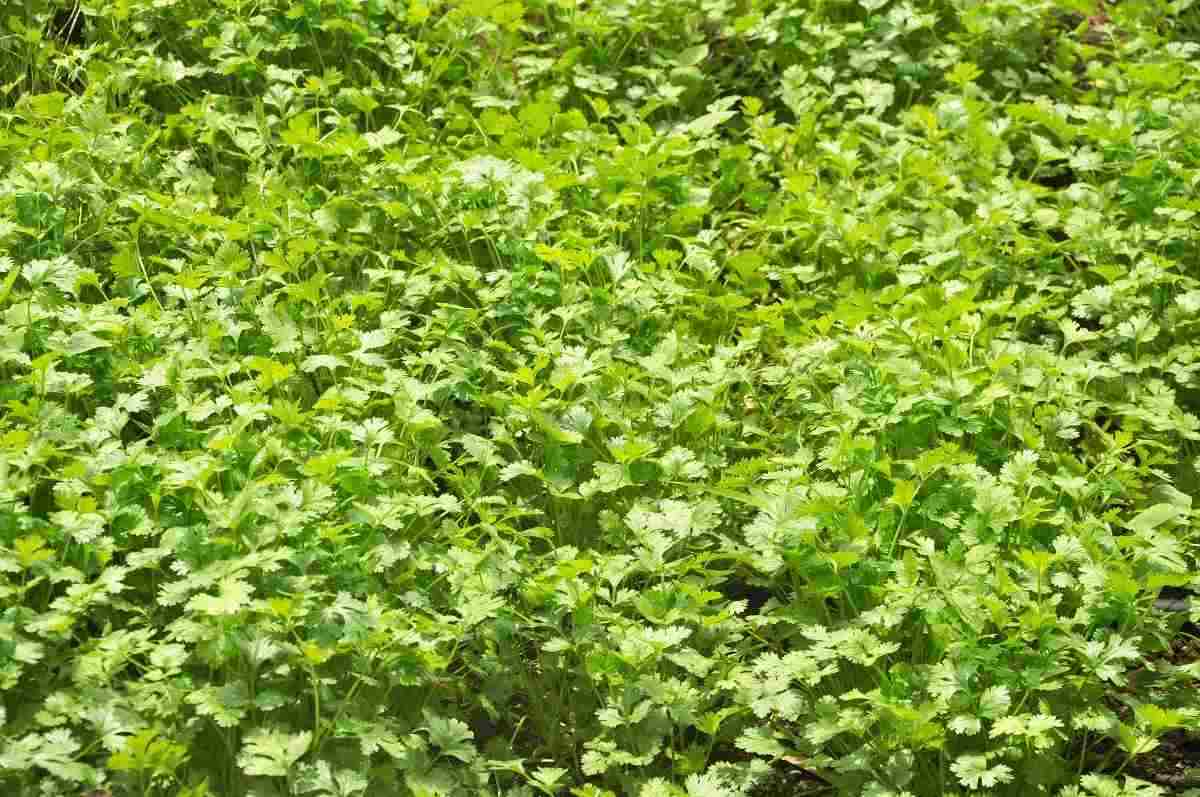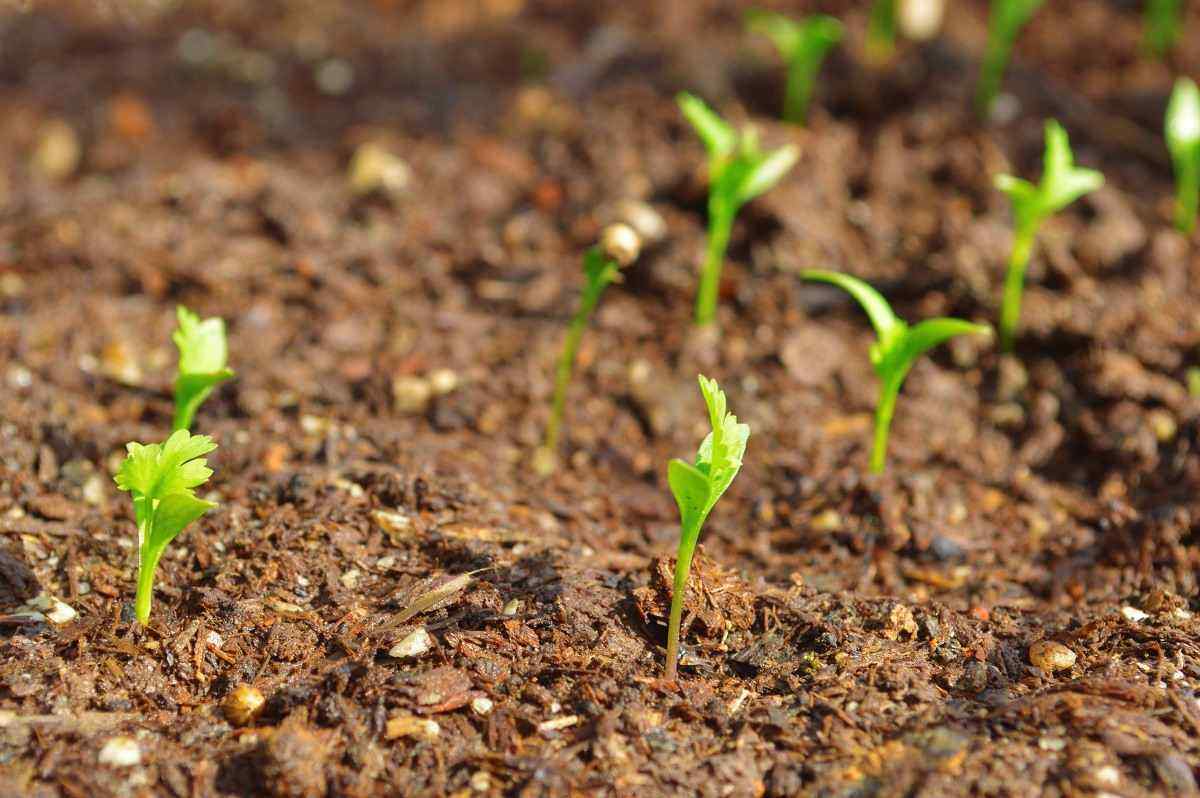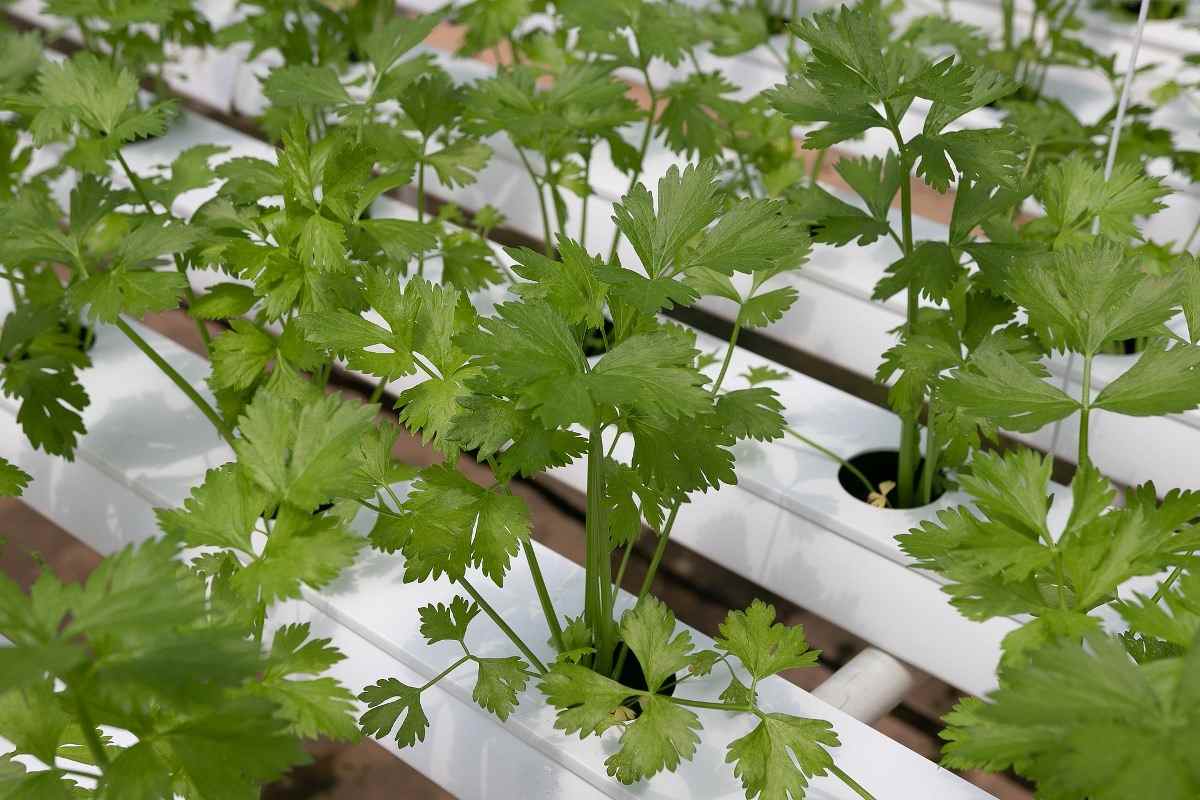Growing Coriander in Greenhouse (Cilantro)
Hello gardeners, we are back with a new topic called how to grow coriander in a greenhouse? Are you interested in growing coriander in Greenhouse? Well, follow this complete article for knowing all the requirements for growing coriander in Greenhouse. This information may be useful for growing coriander (cilantro) in Polyhouse as well.
Introduction to Growing Coriander in Greenhouse
This plant is produced from the round and tan-coloured seeds of the coriander plant. That is called Coriandrum sativum and the Coriander plant is a spice plant. It is a member of the parsley family. The word coriander is used to describe the entire plant that is leaves, stems, seeds, and all. The coriander plant is an annual herb that belongs to the family of Apiaceae. It is also called Chinese parsley or cilantro. All the parts of a coriander plant are very edible, but their very fresh leaves and the dried seeds are the parts most traditionally used in cooking dishes.
A Step By Step Guide for Growing Coriander in Greenhouse
- How to Grow Hibiscus from Flower
- Plantation Ideas for Home Decoration: A Beginners Guide
- Flower Garden Designs and Layouts for Beginners
- Planting and Spacing Techniques in Papaya: A Beginner’s Guide
- Growing Gold: Essential Techniques for Planting Pineapples
- How to Make Kalanchoe Plant Bushy: Home Remedies and Solutions
- 11 Reasons Why Your Gardenia is Not Blooming: Home Remedies and Solutions
- Eco Elegance: The Guide to Designing a Drought-Tolerant Landscape
- Gardening on a Slope: Strategies for Hillside Landscaping
- Nourish and Flourish: Top Organic Mulches for Thriving House Plants
- Everything You Want to Know about Indian Mogra Flower: Discover Uses and Growing
- Green Thumb Success: Expert Tips for Cultivating Greenhouse Pumpkins All Year Round
- Maximize Growth & Flavor: The Ultimate Guide to Companion Planting in Herb Gardens
- How to Control Rhododendron Problems Naturally: Home Remedies and Organic Ways to Fix Them
- Natural Magic: The Remarkable Benefits of Cinnamon for Plants

Coriander or Chinese parsley is a very deep green and savory-leaved herb used to flavor South American, Arabic, and Asian dishes. It is very easy to grow especially in a greenhouse because unlike most plants, you can plant it directly in the soil. In the United States, the stalks and leaves of the coriander plant are considered Cilantro while only the seeds are considered Coriander. In this article, we can call everything Coriander.
Coriander or Cilantro can be grown anywhere and is very easy to grow. It is widely grown and farmed all over India. Coriander can very easily be grown on a farm, in a pot, a container, a greenhouse, etc.
Advantages of Growing Coriander in Greenhouse
- Greenhouse planting is much better than open land planting
- The yield can be 2 to 10 times higher than that of an open plantation
- It can reduce the lobar cost
- Water, compost, chemicals, and pesticide requirements are very less
- It is very easy to operate, maintenance and control
- Pest and diseases control fast and very easy
- Plant favourable and controllable ecological system
- Easy adaptable for the modern technology of farming etc.
Suitable Soil for Growing Coriander in Greenhouse
It needs very well-drained sandy, loam soil, and mulching of the soil is very essential to prevent weed growth. Land retaining manure residue from a plant grown earlier is ideal for the plantation of Coriander.
Coriander Seed Germination in Greenhouse
In case if you miss this: Growing Organic Lavender.

Germination of Coriander takes up to nearly three weeks. Coriander seeds are generally the simplest to germinate. Thin your young plants to 20cm apart to permit them to develop to their full size. Water them in dry periods and confirm the soil never dries out. If the flowers are developed remove them immediately and this ensures the plants focus their energy on growing new leaves. Re-sow the Coriander for every 3 weeks to make sure that you have got a continuing supply during the summer.
You need to plant the Coriander seeds in spring when soil temperatures range between 55 to 68 degrees Fahrenheit. Then the seeds will germinate within 2 or 3 weeks and very quickly produce leafy growth.
Maintain the soil moist and expect to ascertain seed germination around 7 days after the seeds were planted. After 7 days or less, under the soil, the Coriander should have a white sprout beginning of the seed.
How to Treat Coriander Seeds Before Sowing
For quick and fast germination, before sowing better crush and break the Coriander seeds into two parts. Before sowing, you need to soak the seeds in water for 8-12 hours. To prevent the plant from wilt, root rot, and damping-off disease, treat the seeds with Trichoderma viride or Pseudomonas fluorescents of 4gm/kg of the seeds before sowing them.
Coriander Seed Spacing In Greenhouse
Coriander seeds stored for 15 – 30 days record very better and very early germination than the freshly harvested seeds of coriander. Seeds that are soaked in water for 12 to 24 hours before sowing also enhance very good germination. The whole seeds do not germinate and they need to split into two halves before sowing. The split seeds are then put in rows spaced nearly at 30 to 40 cm apart with 15 cm. the Soil depth must not exceed 3.0 cm. nearly about 3 to 5 seeds are sown in and seeds are broadcast and covered with a country plow.
Planting Procedure for Growing Coriander in Greenhouse
You need to prepare a patch of soil in your greenhouse. Alternatively, all the gardeners who have greenhouse kits that will have slab bases can grow the herb inside hanging pots, or raised garden beds. You need to add well-composted manure to the soil.
Sow the seeds about a few quarters of an inch deep, nearly 6 inches apart in rows about a foot apart. Coriander seeds germinate after about nearly three weeks.
Add more amount of compost or natural fertilizer when the plants attain a height of about two inches. Add about 55 g or 1.9 ounces is enough for a patch measuring nearly 5ft. × 5ft.
Here Are Some Tips for Growing Coriander in Greenhouse
Coriander is dry weather or climate herb, which means you, should not need to keep the soil so soggy after the plants germinate.
This herb grows very quickly especially inside greenhouses so if you want fresh supply the entire growing season, you need to plant fresh bunches every two to three weeks.
Watering Requirements for Growing Coriander in Greenhouse
Water requirements of growing coriander vary throughout its total life cycle. During planting, the herb requires considerably more and more water to germinate. On average, you need to supply about an inch or 25 mm of water every week.
After germination, you need to reduce the water supply so the patch is damp and not so soggy. In this stage, 10 to 15 mm of water per week will enough.
Fertilizing Your Coriander in Greenhouse
Fertilizing your plants may help to boost the yields and helps to fight against pests and diseases. Fertilizing coriander plants can be done only by using a balanced fertilizer and water-soluble fertilizer. After preparing to fertilize your coriander plant better follow the instructions on the package. As the flowers start to form or appear, and when plants begin to set seed, then you need to stop applying fertilizer to the plant.
Common Problems in Growing Coriander in Greenhouse
Coriander cannot survive more frosty nor more extreme heat or warm conditions. These two conditions may make the leaves turn yellow and lead to the production of seeds instead of luscious and healthy leaves. This is the main reason you need to plant in late spring or when planting in your greenhouse kit to maintain a temperature between 15 – 26°C.
Pests are listed below:
- Aphids
Aphids will attack coriander, by forming clusters around the buds leading to stunted growth of the plant.
Diseases are listed below:
- Powdery mildew
Seed treatment should be done with Pseudomonas fluorescents or Pf 1 of 10 g /kg and by foliar spray of Pf1 2 g/lit or use spray wet table sulphur 1 kg/ha at the time of the initial or starting formation of the disease and second spray at 10 days of interval.
- Wilt
Seed treatment should be done with Pseudomonas fluorescents of 10g /kg and by the soil application of Pf1 of 5 kg/ha
- Grain mould
Grain mold disease can be controlled by spraying Carbendazim 0.1% to the plant at starting stage.
When and How to Harvest Coriander in Greenhouse
Coriander plant harvesting has to be done when the fruits are fully ripe and start or begin changing from green to brown colour. Delaying in the harvest must be avoided lest shattering during harvest and splitting out of the fruits in subsequent processing operations. The Coriander plants are dried and thrashed with sticks, winnowed, and need to be cleaned. For the leaf, pull out the plants once they are 30 to 40 days old.
Coriander is going to be ready for harvest in nearly about 90 to 110 days depending upon the varieties or types and growing season.
When the stems are nearly 4 – 6 inches then cut off individual stems and leaves from the base of the coriander plant. To avoid weakening your Coriander plant only cut off or remove 1/3 of the leaves at any one time.
Commonly Asked Questions about Growing Coriander in Greenhouse

Can I grow coriander with Hydroponics in the Greenhosue?
Yes, You can grow Coriamder/Dhaniya/Cilantro happily in the Greenhouse Hydroponics.
Can I grow coriander in a greenhouse?
Sow hardy annual seeds like coriander, dill, and chamomile directly into the soil. Alternatively, germinate the seeds on window ledges or in a greenhouse, and plant out when frost risks have passed in early to mid-May.
Does the coriander plant regrow after cutting?
Coriander is typically available because the species that’s coriander, although the variability Calypso has good bolting resistance and maybe plant and allowed to regrow several times, and Confetti has fern-like foliage.
Do herbs grow well in a greenhouse?
In their natural habitat herbs thrive in hot and dry conditions so that they grow amazingly well during a summer greenhouse. With a greenhouse, you’ll enjoy your fresh thriving herbs throughout the year. To urge started, plant herbs employing a well-drained soil and confirm the container has room for growth.
Why does my coriander plant keep dying?
The reason for a dying cilantro plant is usually drought thanks to an excessive amount of sun, not watering frequently enough, and fast-draining soil. Overwatering, an excessive amount of nitrogen fertilizer or pots without drainage can cause cilantro to droop, and therefore the leaves show yellow with a dying appearance.
Should I soak my coriander seeds before planting?
Before you plant them within the ground, you would like to organize the cilantro seeds to extend the probabilities that they’re going to germinate. Soak the cilantro seeds in water for about 24 to 48 hours. Remove from the water and permit drying. You ought to not miss the Organic Container Gardening Ideas for Beginners.
How long does it take for a coriander seed to sprout out?
It takes nearly three weeks to sprout out.
Finding the herb within the market is straightforward, and it’s commonly believed that growing its reception may be a long and tiring process. It always takes three weeks for the seeds to germinate and you begin seeing tiny leaves sprouting from the soil.
What is the best way to grow coriander plants?
Coriander does best in well-drained soil and full sun, but will tolerate some shade within the height of summer. Seeds are often slow to germinate – crushing them very gently before sowing can speed up the method. Coriander features a long tap root, so it is best to avoid damaging the roots.
| Mumbai/Bombay | Kolkata | Bengaluru | Jaipur |
| Chennai/Madras | Hyderabad | Secunderabad | Pune |
| Ahmedabad | Surat | Agra | Lucknow |
| Varanasi | Kochi | New Delhi | Chandigarh |
| Bhopal | Visakhapatnam | Nagpur | Madurai |
| Indore | Amritsar | Kanpur | Patna |
| Nashik | Vadodara | Thiruvananthapuram | Dehradun |
| Vijayawada/Guntur | Warangal | Karimnagar | Coimbatore |
| Raipur | Udaipur | Meerut | Ludhiana |
| Jamshedpur | Jabalpur | Guwahati | Gwalior |
| Dhanbad | Faridabad | Rajkot | Srinagar |
| Mangaluru | Aurangabad | Kota | Solapur |
| Asansol | Gandhinagar | Tiruchirappalli | Salem |
| Tirunelveli | Vellore | Tiruppur | Uttara Kannada |
| Chitradurga | Thane | Cuttack | Kannur |
| Jodhpur | Ranchi | Mysore | Bhubaneswar |